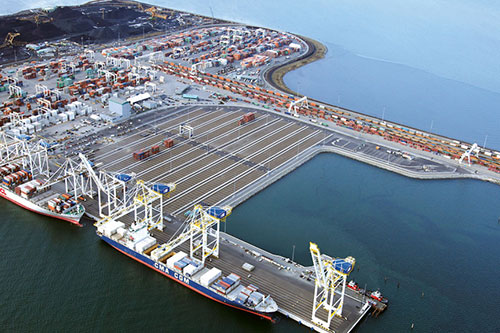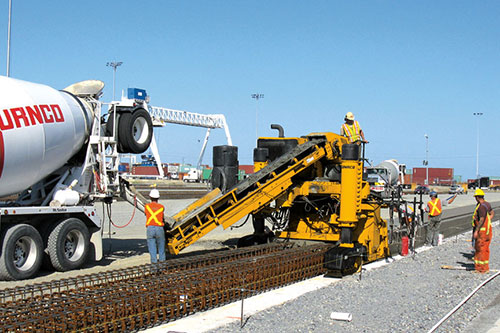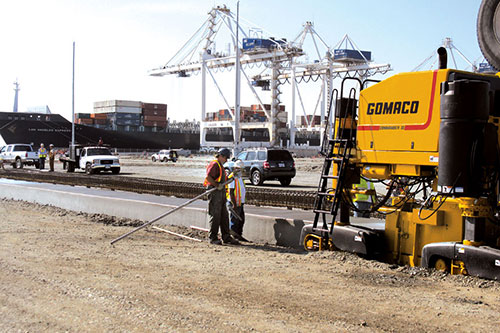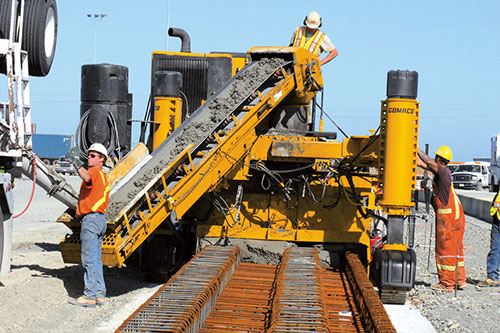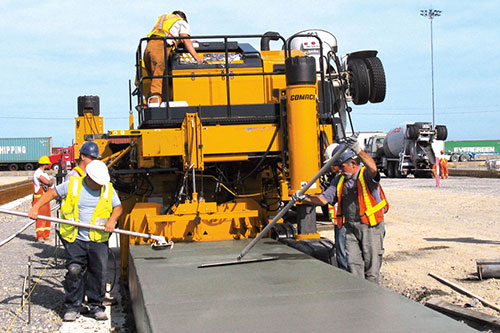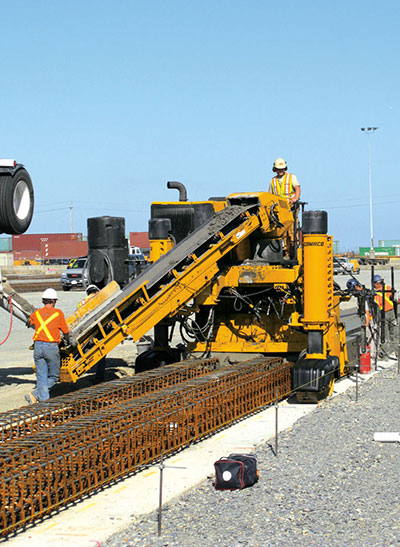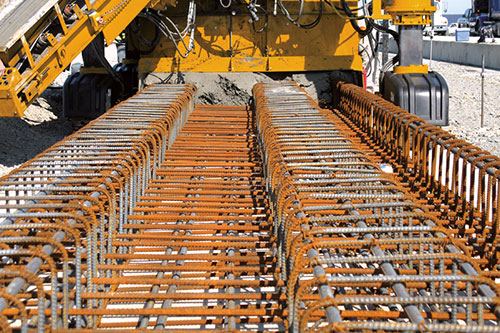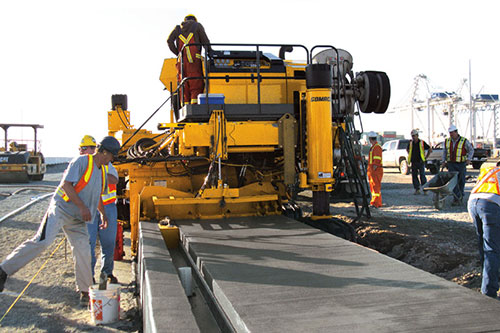GOMACO World Index --- GOMACO World 38.1 - July 2010
36 Crane Runways in Only 33 Days at Vancouver's Deltaport
Container ships dock and wait to be unloaded at Vancouver, British Columbia, Canada's, new Deltaport third berth. A Commander III slipformed new concrete runways for the overhead gantry cranes to operate on.
The Deltaport container terminal in Vancouver, British Columbia, Canada, recently opened a new $400 million third berth. The new berth allows a 50 percent increase in terminal capacity and an additional 20 hectares (49.4 acres) of container storage facilities.
An important part of the construction of the third berth included concrete runways for the new overhead gantry cranes to operate on. Two different profiles of runways were needed, one of them project engineers deemed slipformable. The other profile, which incorporated a drain, was to be handformed.
Coquitlam Ridge Constructors Ltd., located in Coquitlam, British Columbia, a contractor with structural-reinforced concrete experience, was invited to bid the runways and other structural concrete work at the port. The company had no previous slipforming experience, but owns a GOMACO C-450 cylinder finisher. They turned to their GOMACO distributor, LoneTrack Equipment Inc., for help in finding the right machine not only for this project, but also other future slipforming work.
"Most of the people in this area use GOMACO equipment, and we have a familiarity with the company, by just watching their machines on other projects in use around here," Lyle Johnson, Manager for Coquitlam Ridge, said. "Our parent company wanted to procure a machine that could slipform this project, as well as curb and gutter work after this was completed. We determined that the GOMACO Commander III was the machine we needed."
The gantry cranes have a load-bearing capacity of 1160 kilonewtons (116 ton-force) and the capacity to lift containers up to 12 meters (40 ft) long. An intricate system of steel reinforcing would have to be slipformed into the runways to provide the necessary strength and structural support. Also adding to the difficulty of the project was an owner-specified concrete mix design with a silica-fume additive that is not ideally suited for slipforming.
Vancouver's weather only allows a limited construction season and Coquitlam Ridge's work had to be accomplished first before other subcontractors could move in and complete their phases. The pressure was on and everyone was watching Coquitlam Ridge and their new Commander III to see if they could deliver in time.
The Commander III would be slipforming 18 concrete runways, approximately 450 meters (1476 ft) long and spaced 30 or 40 meters (98.4 or 131.2 ft) apart. The limited completion time frame didn't allow for Coquitlam Ridge to send any of their workers to GOMACO University for training. Instead, GOMACO sent a service representative to Coquitlam Ridge to not only set up their new Commander III, but also provide training. The training was so successful, they opted out of test pours, and started right into production with their first pour. It was a success and the Coquitlam Ridge crew never looked back during the course of the project.
Originally, the project called for one runway design to be slipformed. It was a basic rectangular shape, 1.8 meters (5.9 ft) wide across the bottom and 575 millimeters (22.6 in) tall. The other runway, because it contained a drainage channel, was to be handformed. As soon as Coquitlam Ridge secured the bid, they went to work convincing project engineers the second profile was also slipformable. With all of the other subcontractors on the project waiting for them to complete their work, they knew slipforming was their fastest option.
"After we secured the job, we were able to work with the engineer and propose an alternative design that allowed us to slipform a slot in the larger runway and then put the drain system in afterwards," Johnson explained. "By making this change from handforming to slipforming, we cut our work time in half."
Coquitlam Ridge worked with GOMACO engineers to design a block-out section for the drain that could be used with their basic rectangular mold. Since the profile was also wider, a 400 millimeter (15.75 in) insert was designed to attach in the center of the mold, making the width of the second profile 2.2 meters (7.2 ft). The slot drain insert was 270 millimeters (10.6 in) wide at the top, 282 millimeters (11.1 in) deep, and had a male keyway on the right side.
"While we were in the process of designing the mold and developing our casting proposal for the owner, we had some concern about the ability to consolidate the concrete with the large amount of reinforcing steel," Johnson said. "The GOMACO engineers were able to modify our mold and add some flares on the outside of it, which allowed us to drop our vibrators a little lower and help with consolidation. It worked really well."
The concrete mix design specified by the project owner is not ideally suited for slipforming, according to Johnson. It contained a silica-fume additive that made the concrete both hot and sticky to work with and created concerns with tearing as the concrete came out of the mold.
"We added a set stabilizer to the design so the concrete couldn't start hydrating until it reached the job site," Johnson explained. "The key to this project's success was the concrete slump and the concrete temperature."
Concrete slump averaged around 40 millimeters (1.57 in) and was supplied to the job site in mixer trucks carrying eight or 10 cubic meter (10.5 or 13.1 yd3) loads.
"We heard that the weight of the concrete had created challenges with the steel reinforcing on a previous phase, causing it to sometimes move out of alignment," Johnson said. "To anchor the reinforcing from moving, we cast a three meter (10 ft) block at the end of the runway as a starter section. We slipformed approximately 230 lineal meters (755 ft) in a shift, so we would just drive the GOMACO machine over top of the block, start from there, and move on down the line.
"The whole process was governed by our ability to get concrete out of the trucks, and we just weren't able to put concrete in the machine fast enough," Johnson said. "Our best pour rate was over 40 cubic meters (52.3 yd3) an hour, but we usually averaged around 25 cubic meters (32.9 yd3) per hour."
Finishing work behind the Commander III was kept to a minimum. The new concrete runways were bullfloated and then broom finished. Joints were cut every three meters (10 ft).
The first-time slipformers with their new Commander III completed their port project successfully and ahead of schedule.
"We were pretty anxious because we had never used the machine before, and we were under a lot of pressure to get the project done quickly because of the narrow time frame with the weather up here," Johnson said. "Within a day or two of the first pour, we knew we were going to be all right. We did better than all right. We were able to complete all 36 runways, almost nine kilometers (5.6 mi) of paving, in 33 days.
"Originally, we were planning on four months to complete the project, but we accomplished it in under two. We basically knocked off two months from our schedule by being able to slipform all of it."
Deltaport's new third berth has increased its capacity and allows the port to now accommodate the world's largest shipping vessels. Recently the ZIM Djibouti, one of the largest container ships in operation, docked at the Deltaport terminal. The Djibouti has a cargo capacity in excess of 10,000 six meter (20 ft) shipping containers. The port's cranes, operating on their new concrete runways, were able to quickly and efficiently unload the enormous vessel.
And the new three-track Commander III? It is currently slipforming curb and gutter along Vancouver's Sunshine Coast for Coquitlam Ridge Constructors parent company, B.A. Blacktop Ltd.
Subscribe to Receive GOMACO World Magazine
